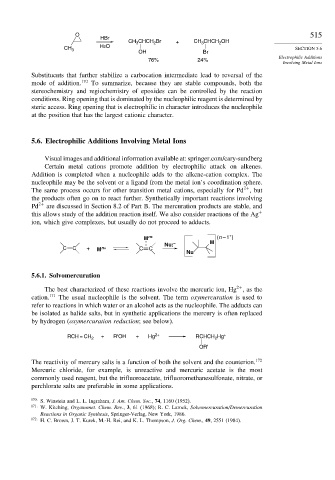Page 534 - Advanced Organic Chemistry Part A - Structure and Mechanisms, 5th ed (2007) - Carey _ Sundberg
P. 534
O 515
HBr
CH CHCH Br + CH CHCH OH
2
3
2
3
H2O
CH 3 SECTION 5.6
OH Br
Electrophilic Additions
76% 24%
Involving Metal Ions
Substituents that further stabilize a carbocation intermediate lead to reversal of the
mode of addition. 170 To summarize, because they are stable compounds, both the
stereochemistry and regiochemistry of epoxides can be controlled by the reaction
conditions. Ring opening that is dominated by the nucleophilic reagent is determined by
steric access. Ring opening that is electrophilic in character introduces the nucleophile
at the position that has the largest cationic character.
5.6. Electrophilic Additions Involving Metal Ions
Visual images and additional information available at: springer.com/cary-sundberg
Certain metal cations promote addition by electrophilic attack on alkenes.
Addition is completed when a nucleophile adds to the alkene-cation complex. The
nucleophile may be the solvent or a ligand from the metal ion’s coordination sphere.
2+
The same process occurs for other transition metal cations, especially for Pd , but
the products often go on to react further. Synthetically important reactions involving
Pd 2+ are discussed in Section 8.2 of Part B. The mercuration products are stable, and
this allows study of the addition reaction itself. We also consider reactions of the Ag +
ion, which give complexes, but usually do not proceed to adducts.
+
M n+ (n – 1 )
Nu: – M
C C + M n+ C C
Nu
5.6.1. Solvomercuration
2+
The best characterized of these reactions involve the mercuric ion, Hg ,asthe
cation. 171 The usual nucleophile is the solvent. The term oxymercuration is used to
refer to reactions in which water or an alcohol acts as the nucleophile. The adducts can
be isolated as halide salts, but in synthetic applications the mercury is often replaced
by hydrogen (oxymercuration reduction; see below).
RCH = CH 2 + R'OH + Hg 2+ RCHCH Hg +
2
OR'
The reactivity of mercury salts is a function of both the solvent and the counterion. 172
Mercuric chloride, for example, is unreactive and mercuric acetate is the most
commonly used reagent, but the trifluoroacetate, trifluoromethanesulfonate, nitrate, or
perchlorate salts are preferable in some applications.
170
S. Winstein and L. L. Ingraham, J. Am. Chem. Soc., 74, 1160 (1952).
171 W. Kitching, Organomet. Chem. Rev., 3, 61 (1968); R. C. Larock, Solvomercuration/Demercuration
Reactions in Organic Synthesis, Springer-Verlag, New York, 1986.
172
H. C. Brown, J. T. Kurek, M.-H. Rei, and K. L. Thompson, J. Org. Chem., 49, 2551 (1984).

